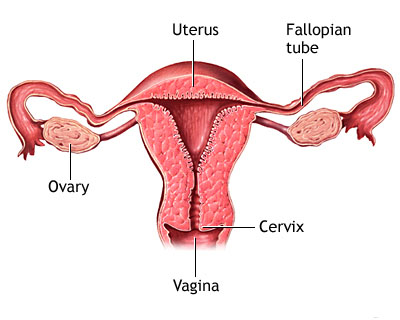Cervical dysplasia
Contents
When to Contact a Medical Professional
Cervical dysplasia refers to abnormal changes in the cells on the surface of the cervix. The cervix is the lower part of the uterus (womb) that opens at the top of the vagina.
The changes are not cancer. But they can lead to cancer of the cervix if not treated.

Causes
Cervical dysplasia can develop at any age, but is most often seen in women ages 25 to 35.
Most often, cervical dysplasia is caused by the human papilloma virus (HPV). HPV is a common virus that is spread through sexual contact. There are many types of HPV. Some types lead to cervical dysplasia or cancer. Other types of HPV can cause genital warts.
The following may increase your risk of cervical dysplasia:
- Having sex before age 18
- Having a baby before age 16
- Having multiple sexual partners
- Having other illnesses or using medicines that suppress your immune system
- Smoking
Symptoms
Most of the time, there are no symptoms.
Exams and Tests
You will have a pelvic exam.
Cervical dysplasia that is seen on a Pap smear is called squamous intraepithelial lesion (SIL). On the Pap smear report, these changes will be described as:
- Low-grade (LSIL)
- High-grade (HSIL)
- Possibly cancerous (malignant)
- Atypical glandular cells (AGUS)
You will need more tests if a Pap smear shows abnormal cells or cervical dysplasia. If the changes were mild, follow-up Pap smears may be all that is needed.
A biopsy to confirm the condition is often needed, however. This may be done using:
- Colposcopy-directed biopsy
- Cone biopsy
- LEEP excision may be done after colposcopy
Dysplasia that is seen on a biopsy of the cervix is called cervical intraepithelial neoplasia (CIN). It is grouped into three categories:
- CIN I -- mild dysplasia
- CIN II -- moderate to marked dysplasia
- CIN III -- severe dysplasia to carcinoma in situ
Some strains of human papillomavirus (HPV) are known to cause cervical cancer. An HPV DNA test can identify the high-risk types of HPV linked to this cancer. This test may be done:
- As a screening test for women over age 30
- For women of any age who have a slightly abnormal Pap test result
Treatment
Treatment depends on the degree of dysplasia. Mild dysplasia (LSIL or CIN I) may go away without treatment.
- You may only need careful follow-up by your doctor with repeat Pap smears every 6 to 12 months.
- If the changes do not go away or get worse, treatment is needed.
Treatment for moderate-to-severe dysplasia or mild dysplasia that does not go away may include:
- Cryosurgery to freeze abnormal cells
- Laser therapy, which uses light to burn away abnormal tissue
- LEEP (loop electrosurgical excision procedure), which uses electricity to remove abnormal tissue
- Surgery to remove the abnormal tissue (cone biopsy)
- Hysterectomy (in rare cases)
If you have had dysplasia, you will need to have repeat exams every 12 months or as recommended by your doctor.
Outlook (Prognosis)
Early diagnosis and prompt treatment cures most cases of cervical dysplasia. However, the condition may return.
Without treatment, severe cervical dysplasia may change into invasive cancer. It can take 10 or more years for cervical dysplasia to develop into cancer. The risk of cancer is lower for mild dysplasia.
When to Contact a Medical Professional
Call our health care provider if you are age 21 or older and have never had a pelvic exam and Pap smear.
Prevention
Ask your health care provider about the HPV vaccine. Girls who receive this vaccine before they become sexually active reduce their chance of getting cervical cancer.
You can reduce your risk of developing cervical dysplasia by taking the following steps:
- Do not smoke. Smoking increases your risk of developing more severe dysplasia and cancer.
- Get vaccinated for HPV between ages 9 and 26.
- Do not have sex until you are 18 or older.
- Practice safe sex, and use a condom.
- Practice monogamy. This means you have only one sexual partner at a time.

